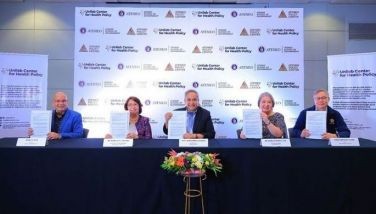UMC grand revival/ Justice on wheels

Retired Supreme Court Chief Justice Reynato S. Puno is hot on the campaign trail, crisscrossing Luzon, visiting various provinces — Bataan, Pampanga, Tarlac, Cavite, Nueva Ecija and Bulacan — and many parts of Metro Manila to personally invite the clergy and lay members of the United Methodist Church to join a grand revival tomorrow, Nov. 30, at the Ultra in Pasig.
The former SC chief admits it is a real challenge to fill up the Ultra coliseum with some 8,000 people. It is rare to hear of a lay member of the church getting out of his way, plunging into an organizing nightmare involving thousands, spending his own money and, of course, precious time, so the church he loves would continue to be spiritually meaningful and socially relevant.
“The UMC is not dead,” Chief Justice Puno declares. “It just needs resuscitation.” His effort to “resuscitate,” or as they call the campaign itself, to “REVIVE” the United Methodist Church makes much sense. The UMC has been a relevant player in the growth of the Protestant faith in the Philippines. Since 1898, the UMC has done a lot for the next several decades for the newly independent nation. It built modern hospitals, schools and other institutions that helped in the transition of the former Spanish colony into the 20th century.
The extra mile that Chief Justice Puno has been putting in so as to revive his beloved church is inspiring. Will he be able to stoke the fire in the hearts of his fellow United Methodists enough? We will see tomorrow.
* * *
On another front, Imagine court hearings being conducted inside a bus. Imagine people who have been detained in jail for many years finally being heard, and, more importantly released, after a judge heard their cases inside a parked vehicle with the words “Justice on Wheels” printed on its sides.
Three weeks ago, two such mobile courts were parked in front of the Quezon City Hall. Inside one “court room,” judges reviewed cases, and by lunchtime, released eight detainees who had languished at the Camp Karingal detention centers for a long time. Similarly, in the other bus, mediators who listened to disputes, dismissed 58 cases.
Justice in a jiffy, observers would say. Or, like Mohamad being not able to go to the mountain, letting the mountain come to Mohamad, if one can’t bring litigants to court, bring the court to them. That’s precisely what the Justice on Wheels (JOW) program of the Supreme Court seeks to do. Make justice accessible to poor detainees, as well as declog the court dockets burdened with mountains of cases.
The idea of having a Justice on Wheels (JOW) program was hatched during the time of former Supreme Court Chief Justice Hilario Davide, and during the term of CJ Reynato S. Puno, the program became Enhanced Justice on Wheels
(EJOW) because of expanded aspects, including justices and judges visiting inmates at their dormitories, providing inmates medical and dental services, and engaging magistrates and police enforcers in dialogues.
In her speech at the launching of EJOW in Quezon City, Chief Justice Maria Lourdes Sereno said the program has given “a viable face to the meaning of justice.” She said the program is intended to expedite trials and conclude them “by accelerating actions that may be taken on some of the cases that are very near to their logical conclusion”; 2) allowing mediation of dispute resolutions inside buses; 3) the presence of the buses impels the local courts to process cases faster, even those that do not necessarily lead to termination or closure; 4) the jail visitation by the magistrates of inmates in detention centers educates them on the actual conditions of the inmates, and ‘opens the inmates’ eyes to the fact that justices and judges do care about them as human beings.’”
SC Associate Justice Mariano Del Castillo, who chairs the EJOW, told me of the quality of justice being dispensed more quickly for inmates. “It’s significant. One day in jail is hell,” he said. The inmates suffer while in detention. While waiting, they see no fiscal, no judge, no courtroom. At the women’s detention center in Camp Karingal, more than 500 women visited had been jailed for many years, their cases ranging from theft to illegal recruitment to homicide, and their hope for being heard uncertain.
Justice Del Castillo talked about the penology conditions and the slow movement of justice that compelled the creation of the EJOW program, at the Peer- Assistant Network Community of Practice Meeting in Croatia last September.
He described the “deplorable, inhumane, and substandard conditions” of Philippine jails. Most are overcrowded, congested, and lack proper ventilation. “The smell alone could make you faint.” Inmates would thus suffer from skin and
other health problems. Some have died of dengue from mosquito bites. According to Justice Del Castillo, the Philippines’ Bureau of Jail Management and Penology data show that as of May 2012, there is a whopping 318 percent congestion rate. In the National Capital Region alone, 22 out of 24 jails are congested. Ideally, the jails in the National Capital Region could accommodate 4,361 inmates. In reality, however, 18,107 inmates are presently detained thereat. (To be continued)
* * *
- Latest
- Trending























